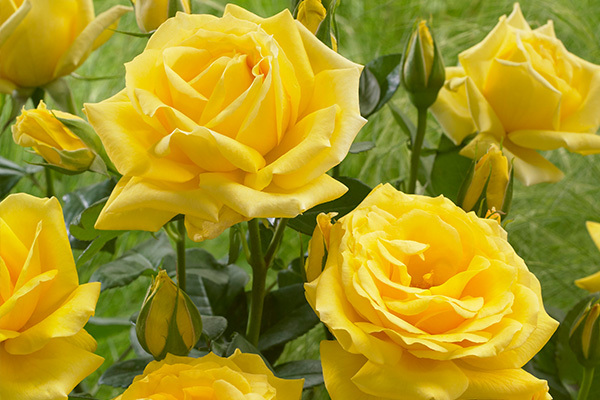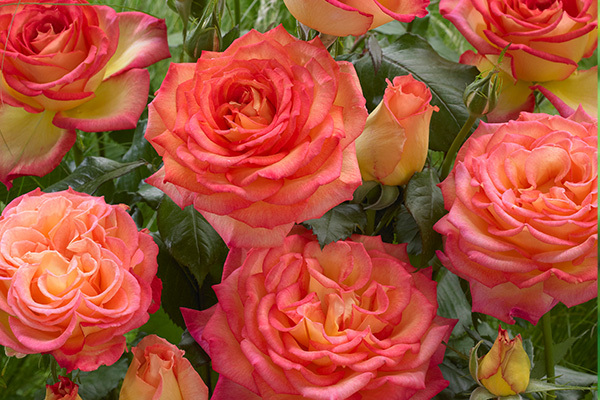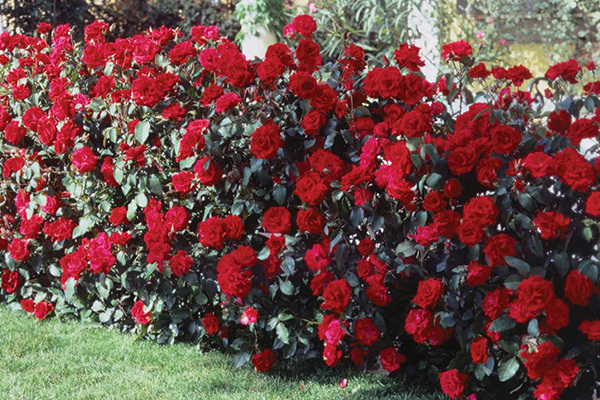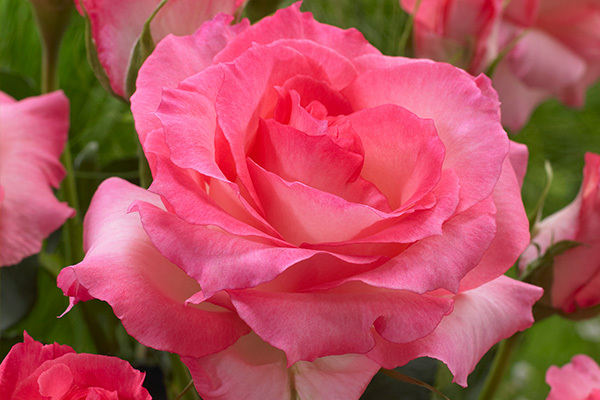
What We've Included
When to Plant | How to Plant | Where to Plant | When to Water | Feeding | Pruning | Overwintering | Common Issues & How to Solve Them | When will they Flower?
When to Plant
Bare root Roses can be any time between Autumn and Spring, if the ground isn’t frozen.
Potted Roses can be planted all year round, but preferably soon after you’ve brought them home and before they start actively flowering.

How to Plant
Climbing Roses
Climbing roses can be trained to climb up all kinds of structures, like trellises, walls, and pergolas. Their beauty knows no bounds and provides the garden with a classic cottage look.
A dry and frost-free day is the perfect climate for growing your climbing roses. Dig a hole in your desired spot that’s twice the depth and width of the root ball, adding some organic matter to the bottom of the hole.
Tease the roots and add the root ball to the dug hole, planting it at the same height it would have been in its pot. Backfill with soil and firm it down with your heel. Train the plant as it climbs on supports like a wire frame or trellis, pruning any stems that grow in the wrong direction.
Rambling Roses
If your plant is already in a container, then it can be planted at any time of year. Make sure you pick a dry, frost-free day to plant them out. They’ll need plenty of space, so give them enough space to grow between each plant.
Dig a hole in your desired spot that’s twice the depth and width of the root ball, adding some organic matter to the bottom of the hole. Tease the roots and add the root ball to the dug hole, planting it at the same height it would have been in its pot. Backfill with soil and firm it down with your heel.
Train these roses against walls or structures with strong galvanised wires. These plants will need annual pruning once established. Once they’ve finished flowering, cut back side shoots to just four healthy shoots. Get rid of any dead or damaged stems to the base.
Shrub Roses
Shrub roses are easy to plant and can be done as soon as they have arrived.
Dig a hole in your desired spot that’s twice the depth and width of the root ball, adding some organic matter to the bottom of the hole. Tease the roots and add the root ball to the dug hole, planting it at the same height it would have been in its pot. Backfill with soil and firm it down with your heel.
Rose shrubs need very little pruning if any at all. However, remove dead or damaged wood in January and February to keep the plant healthy.
Patio Roses
Patio roses are the best roses to grow in containers. However, many rose types can also be grown in containers, excluding rambling types.
Rose plants that arrive in a pot can be transferred into a larger pot. Make sure to tease out the roots gently and fill the sides with soil. Ensure they are in decently sized pots, preferably 50cm wide/deep.
In the height of summer, ensure the soil is kept moist (not waterlogged), and feed regularly. Plants grown in containers need watering more regularly than those in the ground, as they drain more freely. You can tell if the soil needs watering if it’s dry to the touch.
Where to Plant
The position of your roses will depend on the type you’re growing. However, a sunny spot or somewhere semi-shaded is a great place to start! Make sure your sunny spot gets at least four hours of sunlight per day and avoid growing them somewhere exposed that can be windy.
All but rambling roses can be grown in containers. Rambling roses are great for planting next to walls or to hide something unsightly like an old shed. Patio roses are great for small gardens, and shrub roses are ideal for growing in flower beds. Climbing roses will look sensational on any trellis, pergola, or arbour.

When to Water
Patio roses need watering often throughout long periods of heat, as they’re in containers which are free draining. Other rose types can be watered regularly throughout summer in their first few years, but make sure not to waterlog the soil.
After they’ve established, they may need watering in heavy drought, but otherwise, they will take the moisture that’s naturally present in the soil.
Feeding
Roses are hungry plants. They’ll flower better and grow better with the additional feed! You can also add mulch to the base of the plant, including well-rotted manure to keep it healthy and allow access to important nutrients.
In borders:
Feed roses in borders twice a year. First in March or April, before they flower. Secondly in mid-summer after their first flush of flowers. Sprinkle general-purpose rose fertiliser at the base of the plant, mulching well after.
In containers:
Roses in containers will need feeding more often as they won’t be able to pull their nutrients from the soil like those in the border. Feed patio roses once a fortnight from the middle of spring, through to late summer. Once they start to flower, change to a high potash fertiliser like tomato feed, as it will encourage more flowers.
Pruning
Pruning roses is as important as feeding them regularly. Cutting back the plant hard will produce the strongest growth. Light pruning won’t be as vigorous. Cut an outward-facing bud to prevent them from becoming compact and remove stems that are rubbing or competing for space.
Also remove any ‘snags’, which are short, dead lengths of a stem with no growth. These aren’t likely to produce anything and use all-important energy.

Overwintering
Roses go into dormancy over winter, so are unaffected by winter weather and chilling frosts. You do not need to do anything with them, other than a bit of pruning, if necessary, in Jan/Feb.
Common Issues & How to Solve Them
Rose Rust
Rose rust can be spotted by its distinctive spotting on the leaves, top and bottom. On top, they might appear to be a lighter green, but on the bottom of the leaf, you may see dark spots. To stop this from happening, give roses lots of room around them so air can circulate. You can also prune out congested growth areas.
Aphids
Aphids are annoying pests that can damage your plants. You may notice them cluster on flower buds or young foliage - look out for green or pink insects. They can cause moulds, which affect the plant. However, they are an important part of the garden’s ecosystem. Encouraging predators in the garden like ladybirds, earwigs, overflies, and ground beetles can help reduce the aphid population naturally.
Black Spot
Black spot looks like, well, black spots. More specifically, these can be seen on foliage. This is a serious rose disease, which can reduce the plant’s flowers. To stop this disease from appearing on your roses, try the following: Collect fallen leaves and dispose of them regularly. Pick off any leaves that remain over winter. Prune away stem lesions in spring before any leaves appear.
Replanting
Roses that are replanted in the same spot as another rose can grow poorly or even die. This can be because the old rose plant caused a build-up of diseases or pests. If you must plant the new rose in the same place, then line the hole with cardboard or swap the soil for fresh soil. Mulch the area well once planted and feed well.
When will they Flower?
Roses flower in summer. Some may produce just one flush of blooms. Some varieties can have multiple flushes into autumn. Others may flower all summer long. Check your plant’s flowering dates upon purchase to know when you can expect their display.

Ready to Shop?
